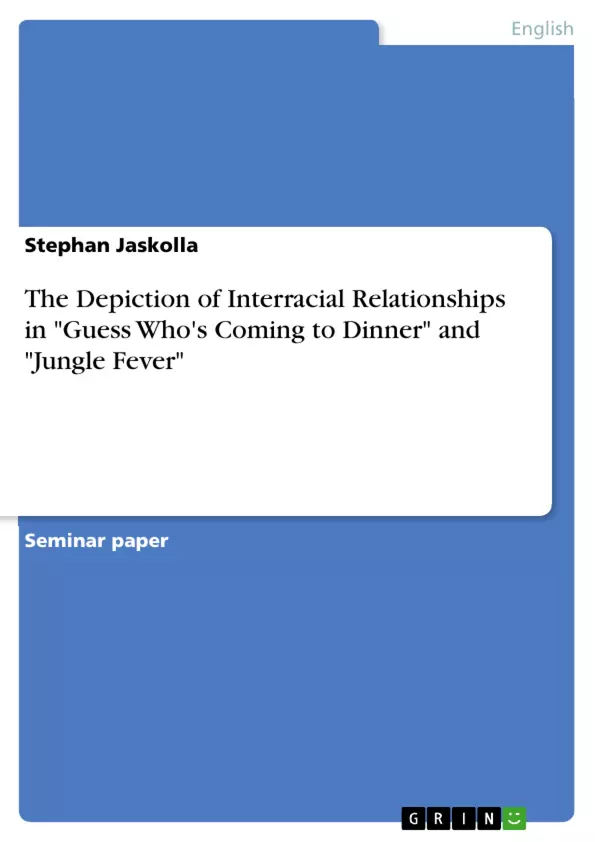The intention of this paper is to assess the extent to which the bi-racial relationships of the main characters of the two movies "Guess Who's Coming to Dinner" and "Jungle Fever" are influenced by their families and communities and how the films differ in their perspective of interracial coupling.
To provide an adequate analysis, it is necessary to make some brief remarks about the historical background of the to movies, as well as providing some basic information about the concept of gender and race as they remarkably influence concept of interracial romances and thus the perception of the two movies. The main part will consist of an analysis of the movies and a comparison of them.
In 1661, Maryland introduced the first miscegenation law in the US. It stipulated that "divers free-born English women, forgetful of their free conditions, and to the disgrace of our nation do intermarry with Negro slaves," and to deter these "shameful matches" the law provided that women who so marry, and their off-spring, should themselves become slaves”. More than 300 years later, in 1967, the "Loving vs. Virginia" trial substantially changed the rights for interracial couples in the United States.
Today, 9.5 percent of American marriages are interracial. Interestingly, only 7 percent of those marriages are between black and white people, amounting to less than 1 percent of all marriages. It seems, as if there is still a barrier in the minds of people regarding the concept of romantic relationships between African-Americans and white citizens.
The topic of bi-racial couples has not only been an issue within the social sciences but also a topic of Hollywood movies like "Guess Who's Coming to Dinner" (which will be referred to as "Guess" throughout this term paper) by Stanley Kramer or Spike Lee's "Jungle Fever". As both movies were created in different periods of time and by directors of different colors they should differ significantly in the ways they present interracial couples and the way they are influenced by their communities and families.
Inhaltsverzeichnis (Table of Contents)
- Introduction
- Basic concepts
- Gender
- Race
- Historical Background
- Historical Background of Guess Who's Coming to Dinner
- Historical Background of Jungle Fever
- Analysis and Comparison
- Analysis of Guess Who's Coming to Dinner
- Analysis of Jungle Fever
- Comparison of Guess and Jungle Fever
- Conclusion
Zielsetzung und Themenschwerpunkte (Objectives and Key Themes)
This paper examines the depiction of interracial relationships in the films Guess Who's Coming to Dinner and Jungle Fever. It aims to assess the extent to which the families and communities of the main characters influence their relationships and how these movies differ in their perspective on interracial coupling. To provide an adequate analysis, the paper explores the historical background of the films and discusses the concepts of gender and race.
- The historical context of interracial relationships in the United States
- The influence of gender roles on interracial relationships
- The impact of race and racial stereotypes on interracial relationships
- The role of family and community in shaping attitudes towards interracial relationships
- The representation of interracial relationships in American cinema
Zusammenfassung der Kapitel (Chapter Summaries)
The introduction presents the historical context of interracial relationships in the United States, starting with the first miscegenation law in Maryland in 1661 and the Supreme Court ruling in Loving vs. Virginia in 1967. It then introduces the films Guess Who's Coming to Dinner and Jungle Fever as examples of cinematic depictions of interracial relationships and outlines the objectives of the paper.
The chapter on basic concepts examines the concepts of gender and race. It discusses the idea of gender as a social construct and explores the implications of gender roles for interracial relationships. It then delves into the concept of race and the historical and social context of racial hierarchies in the United States.
The chapter on historical background provides a historical context for the two films, examining the historical context of interracial relationships during the time periods in which the films were made.
The chapter on analysis and comparison analyzes the films Guess Who's Coming to Dinner and Jungle Fever, examining the depiction of interracial relationships in each film. It discusses the characters' experiences, the themes explored in the films, and the ways in which the films reflect the social and cultural context of the time.
Schlüsselwörter (Keywords)
The key themes and topics explored in this paper include interracial relationships, gender roles, race and racial stereotypes, American cinema, historical context, social and cultural context, family, community, and miscegenation.
- Quote paper
- Stephan Jaskolla (Author), 2016, The Depiction of Interracial Relationships in "Guess Who's Coming to Dinner" and "Jungle Fever", Munich, GRIN Verlag, https://www.hausarbeiten.de/document/494929


